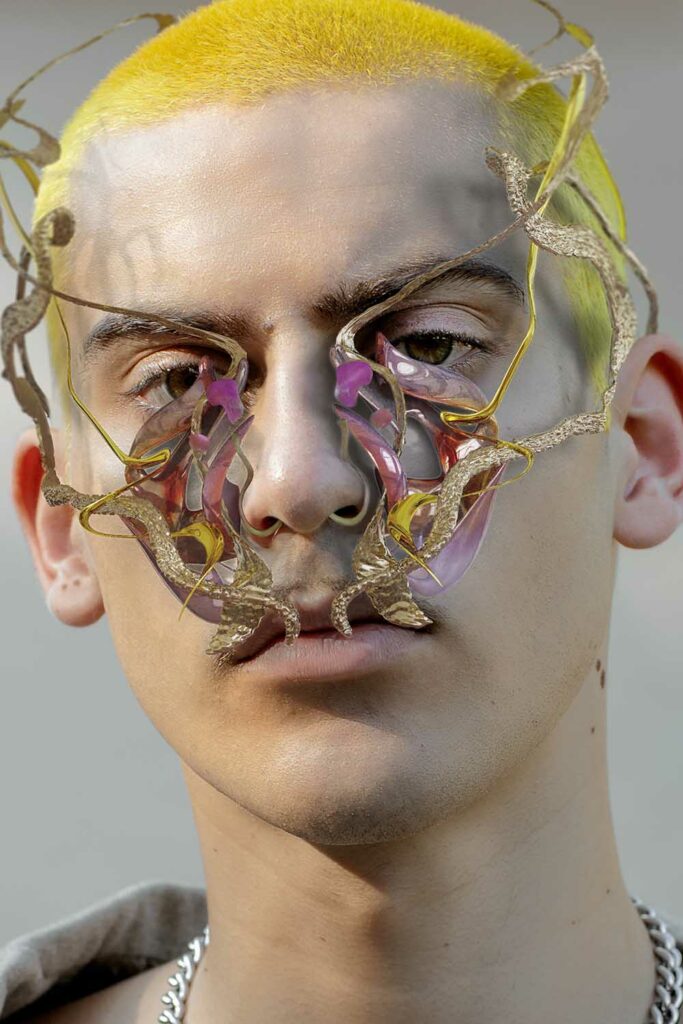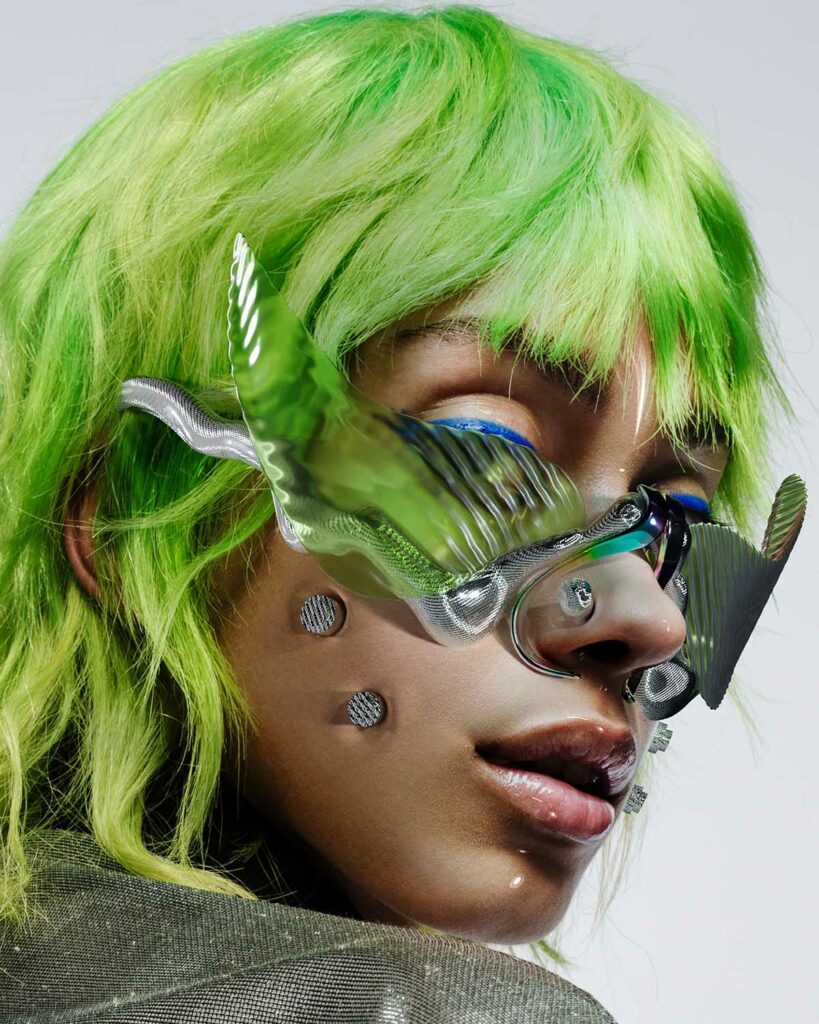
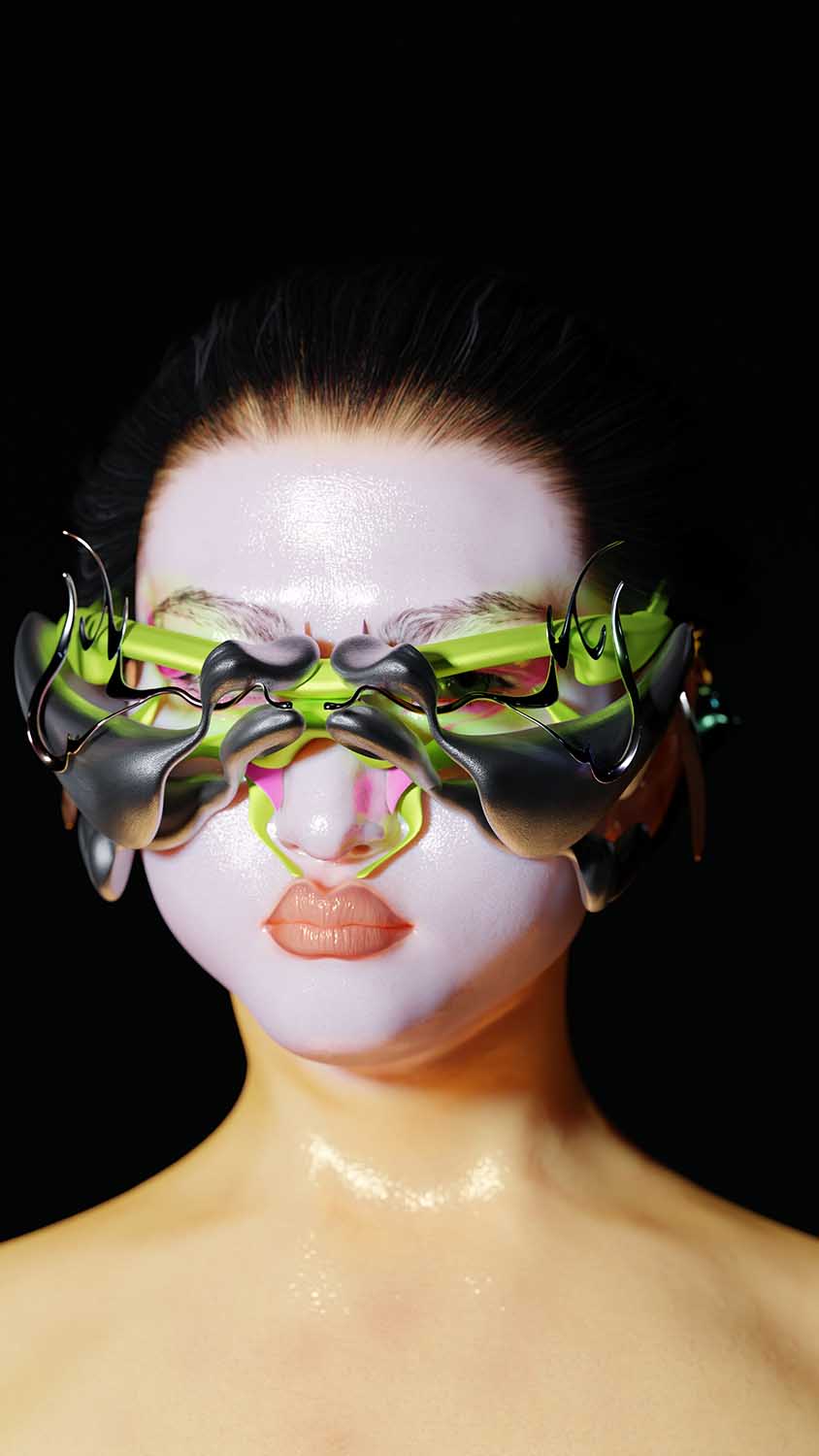
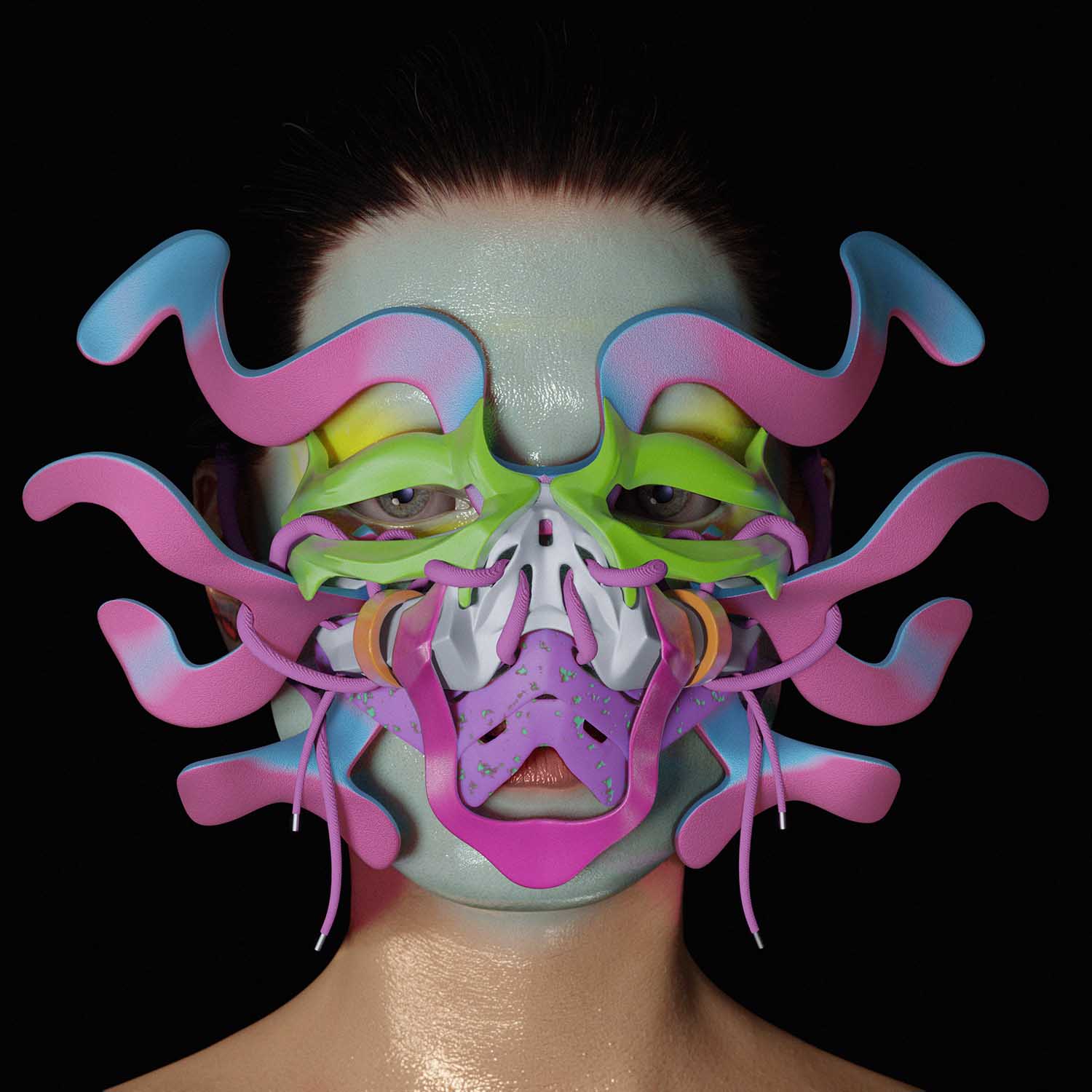
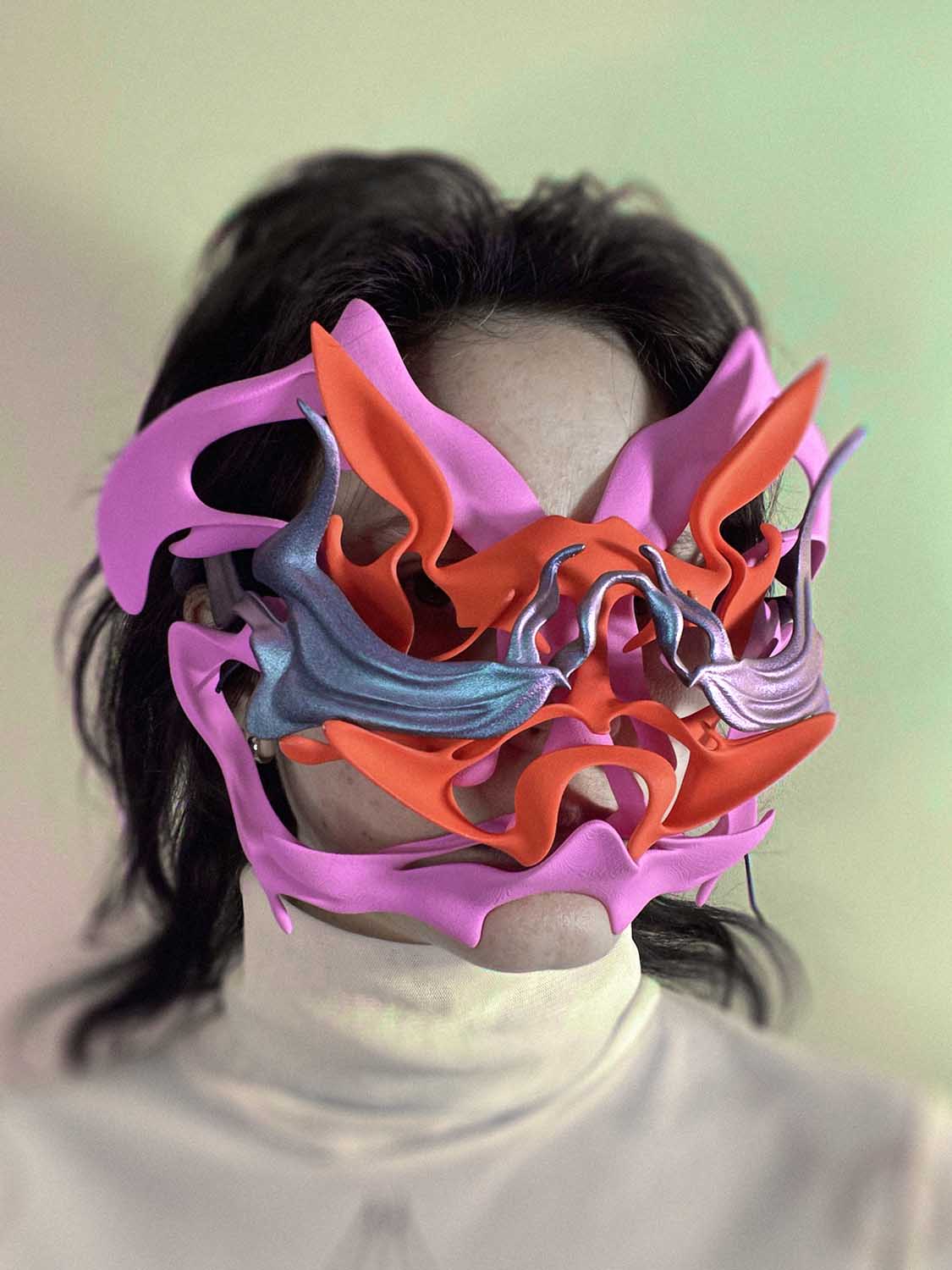
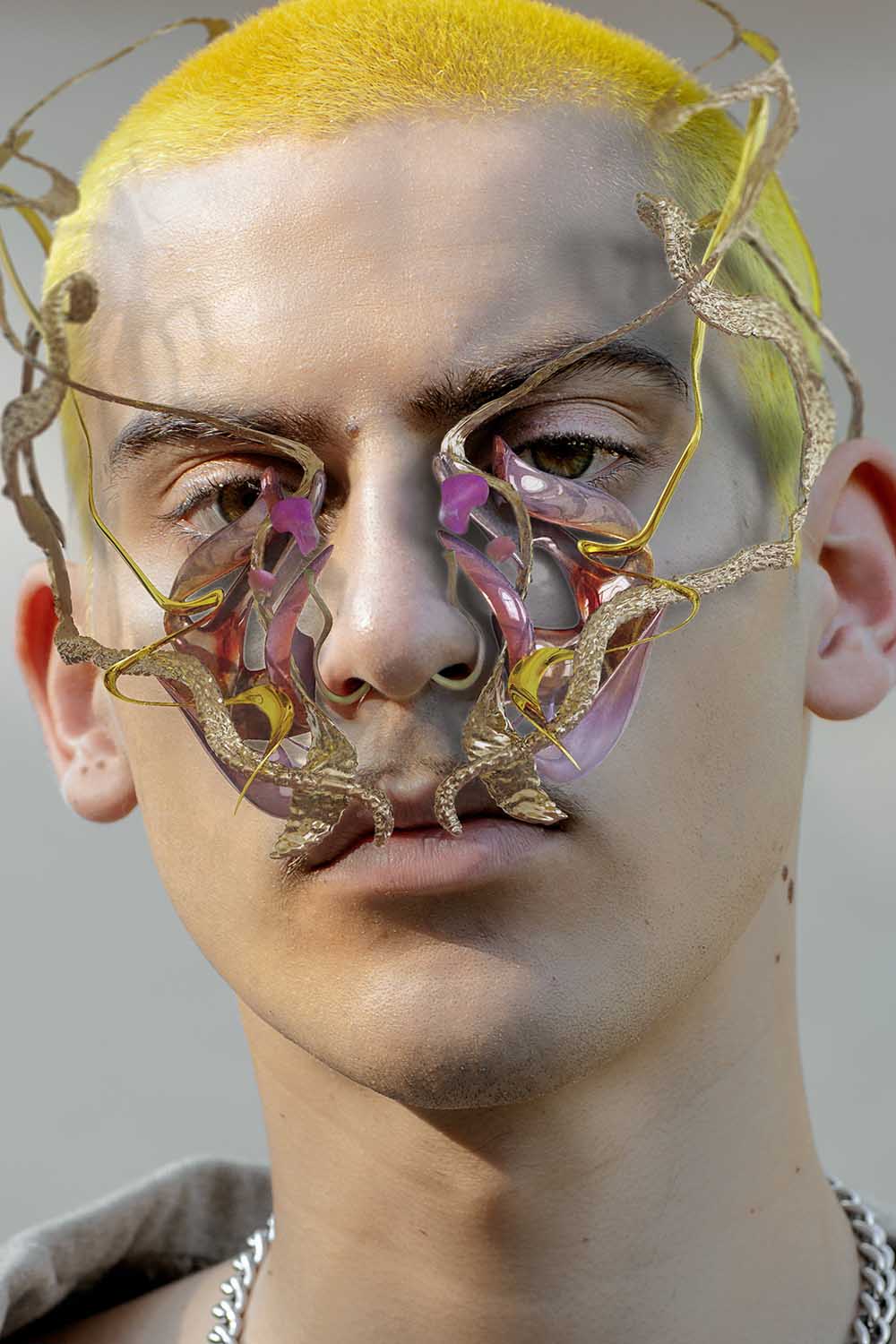
Sarah Mayer
March 2024
Digital artist Sarah Mayer navigating in the technology era. Interview run by Melissa Rizkallah.
TEMPLE MAGAZINE
Would you provide a brief overview of yourself and the work you're engaged in?
SARAH MAYER
My name is Sarah Mayer or sa.m.co on most of my social media platforms. I am from Germany and I grew up in a tiny village surrounded by nature. As a kid I used to go to school, play World of Warcraft, and draw little manga girls on paper, wearing weird swirly clothing. One day when I was around sixteen, a girl in my class came up to me saying I should study fashion after high school. At that time, I had no idea what it was, but I was instantly hooked, and I ended up studying fashion for seven years in between Germany and Amsterdam. I followed a very traditional fashion education. I only had one course using digital fashion as the digital fashion boom burst a year after my graduation.
I like physical fashion, but it's extremely time-consuming, expensive, and it’s not the greatest way to do fashion nowadays, unless you're doing it very cleverly. After graduation, due to a burnout I stopped physical fashion, and I started random jobs. But I'm a creative person, I always need to find my own way somehow. So, I decided to teach myself Blender two hours a day.
TEMPLE MAGAZINE
Right, because what has motivated your desire to introduce yourself to softwares and to create in the digital space?
SARAH MAYER
Well, I lost the desire to buy fabrics, to sew, to do all this process just to create a garment that probably no one's ever going to wear. I decided to stop with physical fashion while it was very easy to continue creating in the digital space. I picked up Blender because it is free, although I didn’t know much about it or any other digital program. As I spent so much time on a computer as a kid, it was easy for me to get into creating in the digital space. I don’t really know why I started creating pieces for the face. It just seemed more intuitive at first than creating something for the whole body. I still feel I’m creating a piece that is fitted, in the same way you create clothing for someone. Then the timing was perfect. Just before Covid, I had created AR (Augmented Reality) effects for the face on Snapchat for the first time, all done with Blender and Lens Studio. It was an instant hit, and I got a job making AR experiences. Now, I've been a freelancer for over a year for the first time of my life, and we’ll see how it goes.
TEMPLE MAGAZINE
As someone creating in the digital space, you are still combining physical and digital elements through AR layers allowing a physical piece to constantly evolve into something new. Is it a practice you want to pursue on doing, or do you tend to leave the traditional way of fashion design behind and only focus on digital?
SARAH MAYER
Definitely want to leave the traditional way of making fashion behind in the sense of how it is done right now. I’ve been in this industry for over ten years and not much has improved. Although digital fashion has arrived, fast fashion is booming. I don’t think people are gonna stop wearing clothes or anything related to physical fashion, at least not in this lifetime. There will always be this need for physical fashion pieces, and this is where I want to combine both practices and create ‘phygital’ pieces. (I want to find a better word for this, it’s a terrible word haha.)
For me, the most ideal way to move forward in the fashion industry, would be to buy a physical piece once. A one time order by demand kind of thing, where I use technology on top of it to update the piece through digital layers altering its fit or color. Fast fashion is driven by the desire to have new stuff. People want new things, stay up to date with trends. Clothing acts as a kind of armor, a weapon to represent yourself to the world in whatever way you want. Sometimes you wanna look cute, sometimes you wanna look fierce. That's where the digital world is so handy. Updating physical pieces with digital layers are versatile and limitless. In general, I think we will be interacting more with digital goods and purchases in this kind of way. I don’t think physical fashion is meant to die, I just think digital perspective is going to become bigger for the new generation as they grew up with it, and use digital goods on a daily basis.
TEMPLE MAGAZINE
When it comes to purchasing a physical piece once in a lifetime and adapting it to your current inspirations, it's a fascinating concept. But how does that translate to buying digital pieces? Are you currently involved in selling NFTs?
SARAH MAYER
Currently, I don’t sell my artwork as NFT. But if you buy an AR layer, it would be like buying any other digital artwork – through a hidden link, NFT or shipped to you with the physical piece. The phygital work I do with my physical masks and sunglasses is focused on the face and uses face tracking or image tracking. But when we are talking about fashion as the whole outfit, we need to find a way to augment the human body and develop a practical UI that makes sense for the user who only has a phone as a device. I think that’s where developments of new devices (like the vision pro) will be coupled a lot with fashion. The more the technology evolves, the more the fashion industry equally evolves. Right now, I mainly use the face because it is available and it tracks well. The face is an easy tool for me to show this concept.
TEMPLE MAGAZINE
In your exploration, you've primarily focused on experimenting with the face. Looking ahead, do you have plans to explore other body parts as well?
SARAH MAYER
For me the whole body is interesting. I always say the face is kind of my muse, as I find it very easy to work with, but all body parts are interesting. I'm also totally into shoes, for example. I find shoes design very interesting when it comes to adding a digital layer to it. Augmenting fashion items in general is going to become huge.
TEMPLE MAGAZINE
In the rapidly evolving landscape of technology, with new software and updates emerging constantly, do you experience pressure as a digital artist to stay abreast of these advancements and push yourself beyond your comfort zone to create art?
SARAH MAYER
It can be quite heavy, yes. Technology is going so fast, and it feels impossible to catch up and know everything. As a digital artist, it’s one of the things that can stress me sometimes. We haven’t talked about it yet, but AI (Artificial Intelligence) is a big topic for digital artists. I am not worried about AI as a digital artist at all. AI simply adds another tool on top of the mountain of possibilities out there and it is a fantastic tool. It is developing so fast, I cannot say in what ways it will influence my work (or not), but it will surely become a naturally integrated part in programs. Snapchat for example released the lens Studio Beta version partnered with Chat Gpt to create a AR effect with prompts. Who knows what AR will look like in a few months from now. I am already integrating AI into my workflow but the speed at which it is developing is hard to catch up sometimes.
TEMPLE MAGAZINE
This highlights the uncertainty surrounding the stability of one's position in the digital art sphere, given the constant evolution of technology. While you may excel in a specific area now, there's always the risk that tomorrow's trends could leave you behind. Does this uncertainty ever concern you?
SARAH MAYER
It is a thought that pops up sometimes although ‘scared’ is maybe a bit too dramatic. I think, as an artist, and especially as a freelancer with no job on the side, you always have to be open to change course. If you're looking outside of the digital world bubble, you will notice that many people have no clue on how it can be used or be helpful. It's a bubble, and I shouldn't forget that for myself sometimes. There are other things out there that I can do. I’ve always been doing lots of different things. Knowing how to 3D print pieces to create physical looks gives me a sense of security. I obviously love the digital world. I think it's brilliant what's happening right now. It's like living in the future truly. But it’s hard to catch up if you're a person like me. I'm just a creative mind. When you take a break away from the online sphere for two weeks, you come back and feel like everything has changed.
TEMPLE MAGAZINE
Do you feel that, at this moment, using Blender as your primary 3D design software enables you to fully conceptualize and express yourself as you'd like?
SARAH MAYER
For sure, I'm talking about 3D printing, but again, it always starts with digital first. It is rare nowadays to find a company that has not integrated digital prototyping. Starting in the digital space first will always be part of my process. It opens up all the possibilities.
TEMPLE MAGAZINE
When you're working on commissioned projects, do you typically start with sketches or dive straight into digital conception? Which tools do you find yourself gravitating towards in your creative process?
SARAH MAYER
Not so long ago, I still used to make sketches with pencil and paper. In fashion studies, lots of things were manual: gluing pictures into a book, making sketches and writing little comments. I know this process and I like it, but I don't do that anymore. What I do now is essentially the same process but done digitally. With AR client projects these days, I actually write a lot of explanatory text, depending on the people I work with.
TEMPLE MAGAZINE
There are lots of organic shapes in your work, and even though you're collaborating on different projects, your visual identity always stands out. Where do you get inspiration from?
SARAH MAYER
What I assume makes me stand out from other people is my background in fashion. When I compose a scene or a piece, I try to make it look fashionable, but I do not intend to create a fashion piece. In fashion school, we would say ‘would you actually wear this yourself’? In the same way, I’m trying to look at it sometimes with my digital art.
As for the organic shapes, sure, nature is always an inspiration because it’s pure creativity. Organic shapes are also easier to model than a hard surface shape. I am getting a bit into hard surface modeling now as well as I want to try to add some sharp edges to my organic designs. The rest is just trying to stay true to my style. I look a lot at other digital artists when it comes to inspiration. Inès Alpha (@ines.alpha) has always been a big inspiration for me, because she's one of the few who is really colorful and knows what she wants while working on many different projects. If I see lots of people doing the same thing, I just don't want to do it. Sometimes, I do think it would be easier to follow the stream.
TEMPLE MAGAZINE
Would you actually wear the pieces you design?
SARAH MAYER
It is a very good question. I have worn my pieces during fashion events or performances, but I wouldn’t go to the supermarket with my masks on. They are art pieces to express myself and a surface to experiment on with AR. I guess that's a good endnote. Many of my future ideas are based on phygital pieces. For instance, to create sunglasses that are way more fab with an AR layer, or to produce more practical physical pieces like lamp shades which can be first displayed in your house via AR. Again branching out in a new direction!
TEMPLE MAGAZINE
Hey Sarah, could you briefly introduce yourself and your work ?
SARAH MAYER
My name is Sarah or sa.m.co on most of my social media platforms. I am from Germany and I grew up in a tiny village surrounded by nature. As a kid I used to go to school, play World of Warcraft, and draw little manga girls on paper, wearing weird swirly clothing. One day when I was around sixteen, a girl in my class came up to me saying I should study fashion after high school. At that time, I had no idea what it was, but I was instantly hooked, and I ended up studying fashion for seven years in between Germany and Amsterdam. I followed a very traditional fashion education. I only had one course using digital fashion as the digital fashion boom burst a year after my graduation.
I like physical fashion, but it's extremely time-consuming, expensive, and it’s not the greatest way to do fashion nowadays, unless you're doing it very cleverly. After graduation, due to a burnout I stopped physical fashion, and I started random jobs. But I'm a creative person, I always need to find my own way somehow. So, I decided to teach myself Blender two hours a day.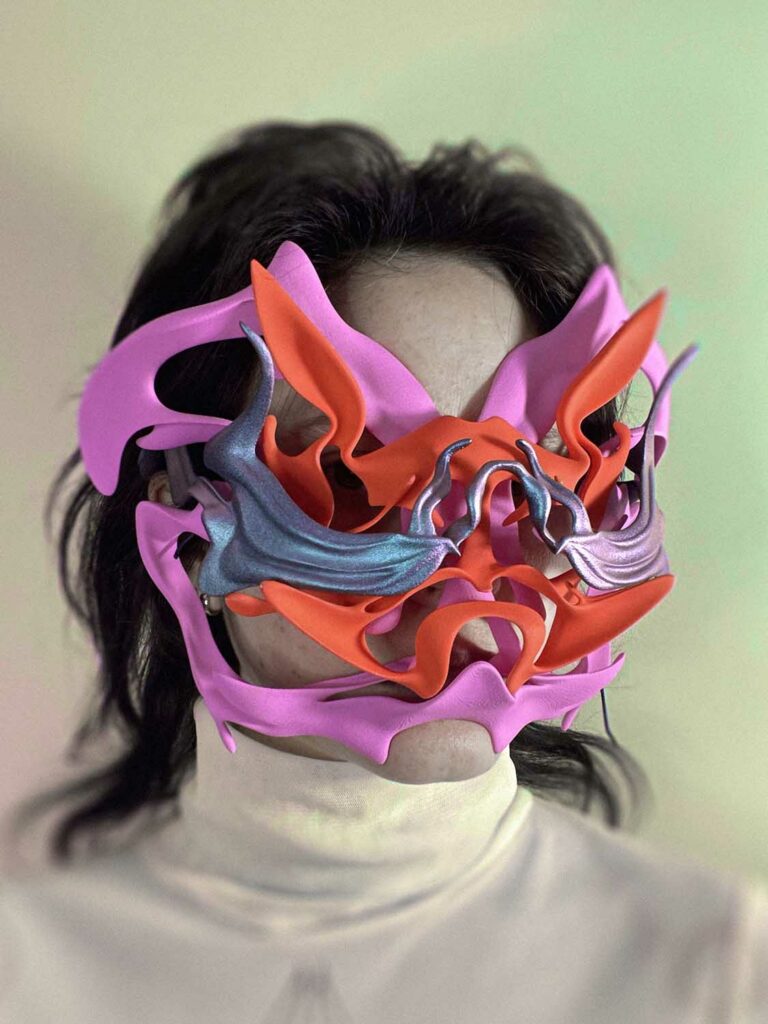
TEMPLE MAGAZINE
Right, because what has motivated your desire to introduce yourself to softwares and to create in the digital space?
SARAH MAYER
Well, I lost the desire to buy fabrics, to sew, to do all this process just to create a garment that probably no one's ever going to wear. I decided to stop with physical fashion while it was very easy to continue creating in the digital space. I picked up Blender because it is free, although I didn’t know much about it or any other digital program. As I spent so much time on a computer as a kid, it was easy for me to get into creating in the digital space. I don’t really know why I started creating pieces for the face. It just seemed more intuitive at first than creating something for the whole body. I still feel I’m creating a piece that is fitted, in the same way you create clothing for someone. Then the timing was perfect. Just before Covid, I had created AR (Augmented Reality) effects for the face on Snapchat for the first time, all done with Blender and Lens Studio. It was an instant hit, and I got a job making AR experiences. Now, I've been a freelancer for over a year for the first time of my life, and we’ll see how it goes.
TEMPLE MAGAZINE
As someone creating in the digital space, you are still combining physical and digital elements through AR layers allowing a physical piece to constantly evolve into something new. Is it a practice you want to pursue on doing, or do you tend to leave the traditional way of fashion design behind and only focus on digital?
SARAH MAYER
Definitely want to leave the traditional way of making fashion behind in the sense of how it is done right now. I’ve been in this industry for over ten years and not much has improved. Although digital fashion has arrived, fast fashion is booming. I don’t think people are gonna stop wearing clothes or anything related to physical fashion, at least not in this lifetime. There will always be this need for physical fashion pieces, and this is where I want to combine both practices and create ‘phygital’ pieces. (I want to find a better word for this, it’s a terrible word haha.)
For me, the most ideal way to move forward in the fashion industry, would be to buy a physical piece once. A one time order by demand kind of thing, where I use technology on top of it to update the piece through digital layers altering its fit or color. Fast fashion is driven by the desire to have new stuff. People want new things, stay up to date with trends. Clothing acts as a kind of armor, a weapon to represent yourself to the world in whatever way you want. Sometimes you wanna look cute, sometimes you wanna look fierce. That's where the digital world is so handy. Updating physical pieces with digital layers are versatile and limitless. In general, I think we will be interacting more with digital goods and purchases in this kind of way. I don’t think physical fashion is meant to die, I just think digital perspective is going to become bigger for the new generation as they grew up with it, and use digital goods on a daily basis.
TEMPLE MAGAZINE
Buying a physical piece once in a lifetime and making it evolve according to your current inspirations is a nice perspective. But how does it work in terms of buying digital pieces? Do you currently sell NFT?
SARAH MAYER
Currently, I don’t sell my artwork as NFT. But if you buy an AR layer, it would be like buying any other digital artwork – through a hidden link, NFT or shipped to you with the physical piece. The phygital work I do with my physical masks and sunglasses is focused on the face and uses face tracking or image tracking. But when we are talking about fashion as the whole outfit, we need to find a way to augment the human body and develop a practical UI that makes sense for the user who only has a phone as a device. I think that’s where developments of new devices (like the vision pro) will be coupled a lot with fashion. The more the technology evolves, the more the fashion industry equally evolves. Right now, I mainly use the face because it is available and it tracks well. The face is an easy tool for me to show this concept.
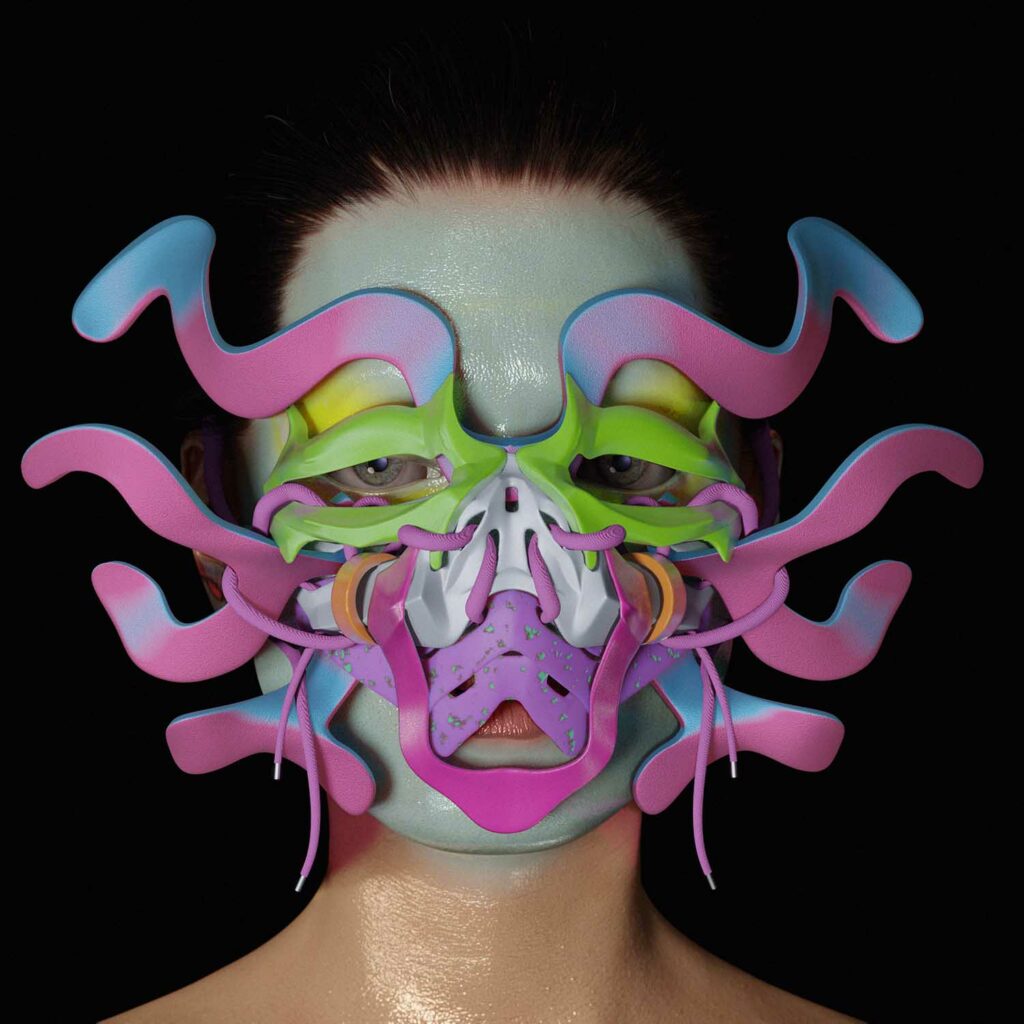 TEMPLE MAGAZINE
TEMPLE MAGAZINE
I know you’ve been experimenting mainly with the face, but in the future are you aiming to experiment with other body parts ?
SARAH MAYER
Yeah, I mean for me the whole body is interesting. I always say the face is kind of my muse, as I find it very easy to work with, but all body parts are interesting. I'm also totally into shoes, for example. I find shoes design very interesting when it comes to adding a digital layer to it. Augmenting fashion items in general is going to become huge.
TEMPLE MAGAZINE
The technology world is moving really fast with new softwares, new updates etc. As a digital artist, do you feel pressure to stay up to date with technological tools and putting yourself out of your comfort zone to produce art ?
SARAH MAYER
It can be quite heavy, yes. Technology is going so fast, and it feels impossible to catch up and know everything. As a digital artist, it’s one of the things that can stress me sometimes. We haven’t talked about it yet, but AI (Artificial Intelligence) is a big topic for digital artists. I am not worried about AI as a digital artist at all. AI simply adds another tool on top of the mountain of possibilities out there and it is a fantastic tool. It is developing so fast, I cannot say in what ways it will influence my work (or not), but it will surely become a naturally integrated part in programs. Snapchat for example released the lens Studio Beta version partnered with Chat Gpt to create a AR effect with prompts. Who knows what AR will look like in a few months from now. I am already integrating AI into my workflow but the speed at which it is developing is hard to catch up sometimes.
TEMPLE MAGAZINE
It means your place is not completely secured as technology keeps on improving. Today, you might specialize in something, but tomorrow the digital art field might be driven by something else and you would be outdated. Is it something you’re scared about?
SARAH MAYER
It is a thought that pops up sometimes although ‘scared’ is maybe a bit too dramatic. I think, as an artist, and especially as a freelancer with no job on the side, you always have to be open to change course. If you're looking outside of the digital world bubble, you will notice that many people have no clue on how it can be used or be helpful. It's a bubble, and I shouldn't forget that for myself sometimes. There are other things out there that I can do. I’ve always been doing lots of different things. Knowing how to 3D print pieces to create physical looks gives me a sense of security. I obviously love the digital world. I think it's brilliant what's happening right now. It's like living in the future truly. But it’s hard to catch up if you're a person like me. I'm just a creative mind. When you take a break away from the online sphere for two weeks, you come back and feel like everything has changed.
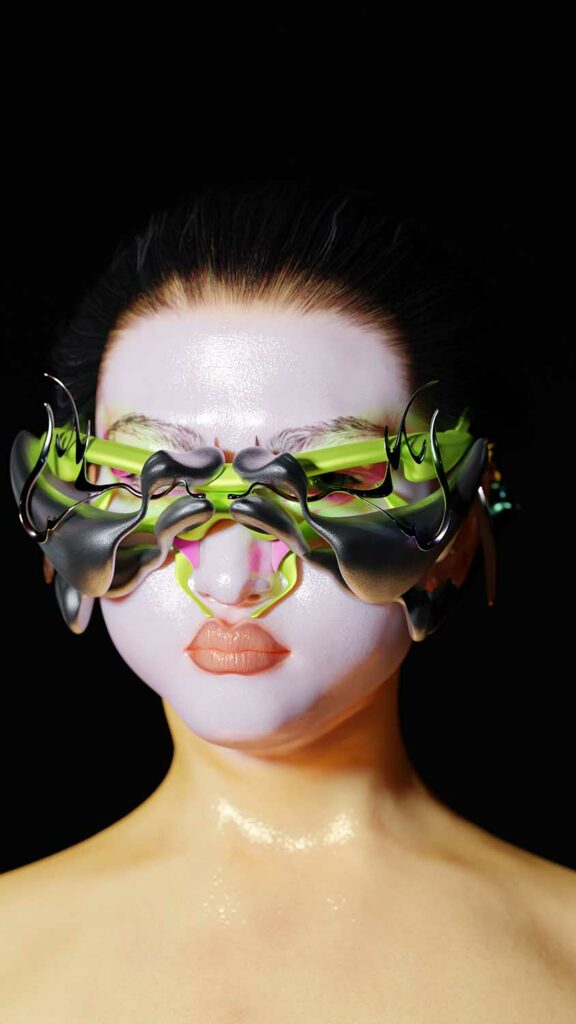 TEMPLE MAGAZINE
TEMPLE MAGAZINE
Do you feel like at this moment, designing on Blender, is the most ideal tool for you to conceptualize and be able to express yourself as you want?
SARAH MAYER
For sure, I'm talking about 3D printing, but again, it always starts with digital first. It is rare nowadays to find a company that has not integrated digital prototyping. Starting in the digital space first will always be part of my process. It opens up all the possibilities.
TEMPLE MAGAZINE
So when you work on commission, do you still draw sketches or is it full digital conception? Which tool do you tend to use in your creative process?
SARAH MAYER
Not so long ago, I still used to make sketches with pencil and paper. In fashion studies, lots of things were manual: gluing pictures into a book, making sketches and writing little comments. I know this process and I like it, but I don't do that anymore. What I do now is essentially the same process but done digitally. With AR client projects these days, I actually write a lot of explanatory text, depending on the people I work with.
TEMPLE MAGAZINE
There are lots of organic shapes in your work, and even though you're collaborating on different projects, your visual identity always stands out. Where do you get inspiration from?
SARAH MAYER
What I assume makes me stand out from other people is my background in fashion. When I compose a scene or a piece, I try to make it look fashionable, but I do not intend to create a fashion piece. In fashion school, we would say ‘would you actually wear this yourself’? In the same way, I’m trying to look at it sometimes with my digital art.
As for the organic shapes, sure, nature is always an inspiration because it’s pure creativity. Organic shapes are also easier to model than a hard surface shape. I am getting a bit into hard surface modeling now as well as I want to try to add some sharp edges to my organic designs. The rest is just trying to stay true to my style. I look a lot at other digital artists when it comes to inspiration. Inès Alpha (@ines.alpha) has always been a big inspiration for me, because she's one of the few who is really colorful and knows what she wants while working on many different projects. If I see lots of people doing the same thing, I just don't want to do it. Sometimes, I do think it would be easier to follow the stream.
TEMPLE MAGAZINE
Last question, would you actually wear the pieces you design?
SARAH MAYER
It is a very good question. I have worn my pieces during fashion events or performances, but I wouldn’t go to the supermarket with my masks on. They are art pieces to express myself and a surface to experiment on with AR. I guess that's a good endnote. Many of my future ideas are based on phygital pieces. For instance, to create sunglasses that are way more fab with an AR layer, or to produce more practical physical pieces like lamp shades which can be first displayed in your house via AR. Again branching out in a new direction!
